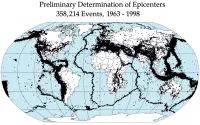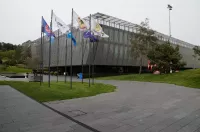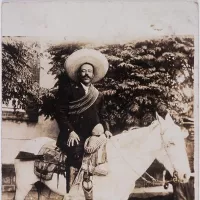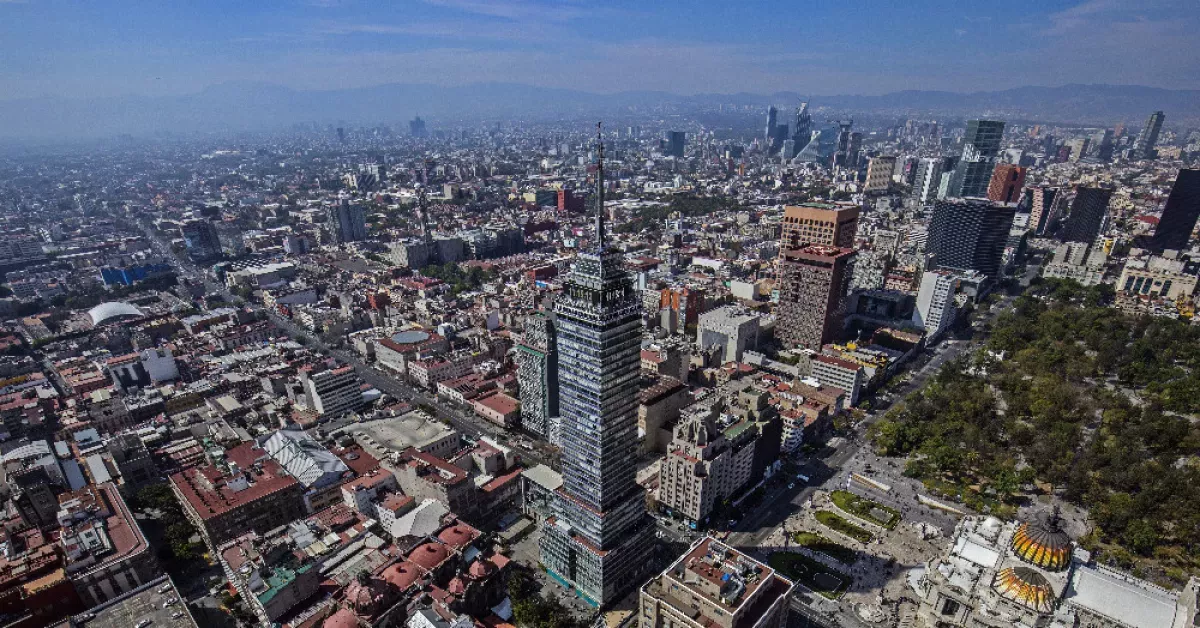Mexico City is the capital and largest city of Mexico and the most populous in North America. A significant cultural and financial hub, it's recognized as an Alpha world city. Located in the Valley of Mexico on the high central plateau at 2,240 meters altitude, the city consists of 16 boroughs (demarcaciones territoriales) divided into neighborhoods (colonias).
1900: Population of Mexico City in 1900
In 1900, the population of Mexico City was approximately 500,000.
1902: Final Adjustments to Mexico City Limits
Between 1898 and 1902, the last changes were made to the limits of Mexico City, reducing the area to the current 1,479 km² by adjusting the southern border with the state of Morelos.
February 1907: Last Known Snowfall
After the snow flurries of 12 February 1907, effects of the draining of Lake Texcoco and global warming have greatly reduced snowfalls
1908: Decrease in Snowfalls
Since 1908, snow has only fallen thrice in Mexico City due to the draining of Lake Texcoco and global warming.
February 1913: Decena Trágica (Ten Tragic Days)
In February 1913, the Decena Trágica occurred, with artillery attacks on the city center during a coup against Francisco I. Madero's government.
July 1914: Entry of Revolutionary Armies
In July 1914, after Huerta's ouster, the armies of Pancho Villa and Emiliano Zapata entered Mexico City without violence.
1921: 1921 Census
According to the 1921 census, 54.78% of Mexico City's population was considered Mestizo, 22.79% European, and 18.74% Indigenous.
1924: Chapultepec Zoo Opened
In 1924, Chapultepec Zoo, located in Chapultepec Park, opened to the public.
1934: Completion of Palacio de Bellas Artes
Construction of the Palacio de Bellas Artes ended in 1934, after being interrupted by the Mexican Revolution in the 1920s.
1940: Leon Trotsky Murdered in Coyoacán
In 1940, Leon Trotsky, who had been granted asylum in Mexico City, was murdered in his house in Coyoacán.
1941: Merging of General Anaya borough
In 1941, the General Anaya borough was merged with the Central Department, which was then renamed "Mexico City".
1959: Jack Kerouac writes Mexico City Blues
In 1959, Jack Kerouac wrote his volume of poetry, Mexico City Blues, in Mexico City.
February 1960: Record Low Temperature
On February 13, 1960, the lowest temperature ever registered at the Tacubaya observatory was −4.4 °C (24 °F).
1960: Population Growth Begins
The 1960's marked the beginning of explosive population growth in Mexico City.
1962: Formula 1 Mexican Grand Prix
From 1962 to 1970, Mexico City hosted the Formula 1 Mexican Grand Prix
1964: Zoo San Juan de Aragon Opened
In 1964, Zoo San Juan de Aragon opened near San Juan de Aragon Park.
January 1967: Heavy Snowfall in Mexico City
In January 1967, 8 centimeters (3 in) of snow fell on Mexico City, the most on record.
1968: Repression of Demonstration
In 1968, a demonstration was violently repressed by a paramilitary group called "Los Halcones".
1968: 1968 Olympic Games
The 1968 Olympic Games led to the construction of large sporting facilities in Mexico City.
1969: Mexico City Metro Opens
In 1969, the first portions of the Mexico City Metro, the largest metro system in Latin America, were opened.
1970: Formula 1 Mexican Grand Prix
From 1962 to 1970, Mexico City hosted the Formula 1 Mexican Grand Prix
1970: Split of Mexico City into delegaciones
In 1970, Mexico City was split into four different delegaciones: Cuauhtémoc, Miguel Hidalgo, Venustiano Carranza and Benito Juárez, increasing the number of delegaciones to 16.
1974: ICF Flatwater Racing World Championships Hosted
In 1974, Mexico City hosted the ICF Flatwater Racing World Championships.
1975: Mexico City Hosted Pan American Games
In 1975, Mexico City hosted the Pan American Games after Santiago and São Paulo withdrew.
1976: Sala Nezahualcóyotl Inaugurated
In 1976, the Sala Nezahualcóyotl concert hall was inaugurated as the first wrap-around concert hall in the Western Hemisphere.
1978: Discovery of Templo Mayor
The Templo Mayor was discovered in 1978 while workers were digging to place underground electric cables.
1979: Last Streetcar Line Closes
In 1979, the central area's last streetcar line (tramway, or tranvía) closed.
1980: Population Growth
By 1980 the city's population more than doubled to nearly 9 million.
1980: Champ Car World Series Gran Premio de México
From 1980 to 1981, the Autódromo Hermanos Rodríguez circuit hosted the Champ Car World Series Gran Premio de México.
1980: Industrial Jobs in Mexico City
In 1980, half of all the industrial jobs in Mexico were located in Mexico City.
1981: Champ Car World Series Gran Premio de México
From 1980 to 1981, the Autódromo Hermanos Rodríguez circuit hosted the Champ Car World Series Gran Premio de México.
September 1985: 1985 Mexico City Earthquake
On September 1985, Mexico City was struck by a devastating earthquake, which exposed the government's ineffectiveness and led to citizen-led rescue and reconstruction efforts.
1986: Formula 1 Mexican Grand Prix
From 1986 to 1992, Mexico City hosted the Formula 1 Mexican Grand Prix
1987: First Statute of Government
In 1987, Mexico City received a greater degree of autonomy with the elaboration the first Statute of Government (Estatuto de Gobierno) and the creation of an assembly of representatives.
1987: Historic Center Enlisted as UNESCO World Heritage Site
In 1987, the Historic center of Mexico City was enlisted as a UNESCO World Heritage Site.
1992: Pollution levels
By 1992, sulfur dioxide and nitrogen dioxide were at levels about a third of those in Mexico City.
1992: Formula 1 Mexican Grand Prix
From 1986 to 1992, Mexico City hosted the Formula 1 Mexican Grand Prix
1993: Constitutional Amendment
In 1993, an amendment to the 44th article of the Constitution of Mexico stated that Mexico City and the Federal District were the same entity.
1994: ICF Flatwater Racing World Championships Hosted
In 1994, Mexico City hosted the ICF Flatwater Racing World Championships.
1997: Political Autonomy Granted
In 1997, residents of Mexico City were granted the right to elect a head of government and representatives of the Legislative Assembly.
1997: Increase in Prison Population
Since 1997, the prison population in Mexico City has increased by more than 500%.
February 1999: Zoo Los Coyotes Inaugurated
On February 2, 1999, Zoo Los Coyotes was inaugurated in Coyoacan.
1999: American Population
In 1999, the U.S. Bureau of Consular Affairs estimated that over 440,000 Americans lived in the Mexico City Metropolitan Area.
2000: Negative net migration rate
Between 1995 and 2000, Mexico City proper experienced a negative net migration rate, indicating that residents were moving to the suburbs of the metropolitan area or to other states of Mexico.
2000: Daily Crime Reports
Between 2000 and 2004, an average of 478 crimes were reported each day in Mexico City, though the actual crime rate was thought to be much higher.
2000: Direct Election of Local Authorities
In 2000, local authorities in Mexico City were first elected directly by plurality.
2002: Champ Car World Series Gran Premio de México
From 2002 to 2007, the Autódromo Hermanos Rodríguez circuit hosted the Champ Car World Series Gran Premio de México.
2002: Human Development Index
In 2002, Mexico City had a Human Development Index score of 0.915, identical to that of South Korea.
2003: Study of Peñon Woman
In 2003, a study placed the age of the Peñon woman at 12,700 years old (calendar age), making her one of the oldest human remains discovered in the Americas.
2004: Daily Crime Reports
Between 2000 and 2004, an average of 478 crimes were reported each day in Mexico City, though the actual crime rate was thought to be much higher.
2005: Mexico City Hosts NFL Regular Season Game
In 2005, Mexico City became the first city to host an NFL regular season game outside of the United States, at the Azteca Stadium. The crowd of 103,467 people was the largest ever for a regular season game in NFL history.
2005: HDI Values
In the 2005 report, the boroughs of Xochimilco, Tláhuac, and Iztapalapa had the lowest HDI values in Mexico City, while Milpa Alta had a "medium" HDI.
2005: Human Development Index
The Human Development Index report of 2005 showed varying levels of HDI among Mexico City's boroughs, with Benito Juárez borough having the highest HDI in the country.
2006: UNAM Ranking
In 2006, UNAM ranked 74th in the Top 200 World University Ranking published by Times Higher Education, making it the highest ranked Spanish-speaking university in the world.
2007: Champ Car World Series Gran Premio de México
From 2002 to 2007, the Autódromo Hermanos Rodríguez circuit hosted the Champ Car World Series Gran Premio de México.
2007: CCU Cultural Center Branch Inaugurated
In 2007, a branch of the National University's CCU cultural center was inaugurated in the facilities of the former Ministry of Foreign Affairs, known as Tlatelolco.
2007: Income of Top Earners
In 2007, residents in the top twelve percent of GDP per capita holders in Mexico City had a mean disposable income of US$98,517.
2007: National Auditorium Selected World's Best Venue
In 2007, the National Auditorium was selected as the world's best venue by multiple genre media.
2007: UNESCO World Heritage Site
In 2007, the main campus of the National Autonomous University of Mexico (UNAM), known as Ciudad Universitaria, was named a World Heritage Site by UNESCO.
2008: Population in 2008
In 2008, Greater Mexico City's population was approximately 19.8 million inhabitants.
2008: Museo Universitario Arte Contemporáneo Inaugurated
In late 2008, the Museo Universitario Arte Contemporáneo, designed by Mexican architect Teodoro González de León, was inaugurated in southern Mexico City.
December 2009: Legalization of Same-Sex Marriage
In December 2009, the then Federal District became the first city in Latin America and one of very few in the world to legalize same-sex marriage.
2009: GDP Ranking
According to a 2009 study conducted by PwC, Mexico City had a GDP of $390 billion, ranking it as the eighth richest city in the world and the richest in Latin America.
2009: Security Upgrade
Under policies enacted by Mayor Marcelo Ebrard between 2009 and 2011, Mexico City underwent a major security upgrade.
2010: Religious Demographics
In 2010, the majority (82%) of the residents in Mexico City were Catholic. This was slightly lower than the national percentage of 87% from the same census, marking a decrease in the proportion of Catholics over the last decades.
2010: Mexico City's HDI Value
Mexico City's 2010 HDI value of 0.9225 (or 0.8307 by newer methodology) was Mexico's highest.
September 2011: Dalai Lama Inaugurates Tibet Exhibit at Memory and Tolerance Museum
In September 2011, the Dalai Lama inaugurated an exhibit on Tibet at the Memory and Tolerance Museum.
2011: Museo Soumaya Inaugurates New Facility
In 2011, the Museo Soumaya inaugurated a new futuristic-design facility just north of Polanco, while maintaining a smaller facility in Plaza Loreto.
2011: Security Upgrade
Under policies enacted by Mayor Marcelo Ebrard between 2009 and 2011, Mexico City underwent a major security upgrade.
September 2013: Ecobici bicycle sharing system expanded
In September 2013, Mexico City's Ecobici bicycle sharing system comprised 276 stations and approximately 4,000 bicycles were available for public use.
2013: 2013 Economy
In 2013, if Mexico City were an independent country, it would be the fifth-largest economy in Latin America.
2013: Shift in Abbreviation Usage
Since 2013, the abbreviation "CDMX" (Ciudad de México) has become more common, particularly by the government, replacing "DF".
2014: Pollution Levels Dropped
By 2014, carbon monoxide pollution in Mexico City had dropped drastically.
2015: City Government Report
A 2015 city government report found that two of three women over the age of 15 in the capital suffered some form of violence.
2015: UNESCO Global Network of Learning Cities
In 2015, Mexico City joined the UNESCO Global Network of Learning Cities.
2015: Formula 1 Mexican Grand Prix Returns
The Formula 1 Mexican Grand Prix returned to the sport in 2015, held at the Autódromo Hermanos Rodríguez.
January 2016: Renaming of Mexico City
On 29 January 2016, Mexico City ceased to be the Federal District and was officially renamed "Ciudad de México" (CDMX), beginning its transition to becoming the country's 32nd federal entity.
January 2016: Federal District Ceases, CDMX is Born
On January 29, 2016, the Federal District (DF) officially became Ciudad de México (CDMX), gaining greater autonomy and changes to its governance.
2016: Political Reforms
After the political reforms in 2016, each borough is headed by a mayor, expanding their local government powers.
2016: High private car usage
In 2016, Mexico City had relatively high private car usage, estimated at more than 4.5 million.
2016: Formula E Mexico City ePrix
In 2016, the Formula E Mexico City ePrix began being held at the Autódromo Hermanos Rodríguez.
2016: Incidence of Femicides
In 2016, the incidence of femicides in Mexico City was 3.2 per 100,000 inhabitants, the national average being 4.2.
January 2017: Ratification of Constitution
As of its ratification on 31 January 2017, Mexico City has a constitution, similar to the states of the Union.
2017: NBA Interest in Mexico City
In 2017, NBA commissioner Adam Silver expressed interest in placing an NBA G League expansion team in Mexico City as early as 2018.
2018: Political Slogan Introduced
During Andrés Manuel López Obrador's administration in 2018, the political slogan "la Ciudad de la Esperanza" (The City of Hope) was introduced.
2018: NBA Interest in Mexico City
In 2017, NBA commissioner Adam Silver expressed interest in placing an NBA G League expansion team in Mexico City as early as 2018.
December 2019: NBA G League Expansion Team Announced for Mexico City
In December 2019, NBA commissioner Adam Silver announced that LNBP team, Capitanes de la Ciudad de México, will be joining the G League in the 2020–21 season on a five-year agreement.
2019: Expansion of the Mexico City megalopolis
In 2019, Querétaro was added to the Mexico City megalopolis as defined by the Environmental Commission of the Megalopolis (CAMe), thus expanding the area covered by the megalopolis.
2019: New Integrated Map and Payment Card for Public Transportation
In 2019, graphic designer Lance Wyman created an integrated map and new logo for the Sistema de Movilidad Integrada. Claudia Sheinbaum announced the branding would be used for a new single payment card to streamline public transportation fare collection.
2019: Restaurant Sud 777 Placed on World's 50 Best Restaurants List
In 2019, the restaurant Sud 777 was placed at 58th on the World's 50 Best Restaurants list.
2020: Indigenous and Afro-Mexican Population
According to the 2020 Census, around 18.74% of Mexico City's population were indigenous peoples, and 2.03% identified as Black, Afro-Mexican, or of African descent.
2020: Population of Mexico City megalopolis
In 2020, the Mexico City megalopolis, officially known as the Corona regional del centro de México, had a population of 33.4 million, representing more than one quarter of the country's population according to the census.
2020: Capitanes de la Ciudad de México Joins G League
LNBP team, Capitanes de la Ciudad de México, will be joining the G League in the 2020–21 season on a five-year agreement
2020: Borough Populations
The provided text mentions the boroughs of Mexico City with their 2020 populations.
2022: Felipe Ángeles International Airport Opens
In 2022, Felipe Ángeles International Airport (IATA Airport Code: NLU) opened as Mexico City's secondary airport. It was rebuilt from the former Santa Lucía Air Force Base.
2023: Mexico City Ranked 13th Best for Restaurants
In 2023, Mexico City ranked 13th best on the World's 50 Best Restaurants list. The Mexican avant-garde restaurant Pujol was recognized.
May 2024: Record High Temperature
On May 25, 2024, the highest temperature on record at the Tacubaya observatory was 34.7 °C (94.5 °F).
2024: Mexico City Restaurants Receive Michelin Stars
In 2024, seven restaurants in Mexico City received Michelin stars.
2024: GaWC 2024 ranking
In 2024, the Globalization and World Cities Research Network (GaWC) classified Mexico City as an Alpha world city.
2025: Ban on Traditional Bullfights Enacted
Prior to the 2025 ban on traditional bullfights enacted by Mexico City's Congress, bullfighting was held every Sunday during the season at the Plaza México.
Mentioned in this timeline

An earthquake is the shaking of the Earth's surface caused...
Korea is a peninsular region in East Asia comprised of...

FIFA F d ration Internationale de Football Association is the...

A car also known as an automobile is a wheeled...
South Korea officially the Republic of Korea occupies the southern...

Pancho Villa was a pivotal figure in the Mexican Revolution...
Trending

8 months ago Dating Rumors Swirl Around Angel Reese and Wendell Carter Jr.; Harvard's Interest

7 months ago House Dems and GOP unite to stop Trump impeachment; Democrat calls it a stunt.

16 days ago Kristi Noem's deportation flight decision faced scrutiny after judge's order, DOJ reveals call.
Emeka Egbuka is an American football wide receiver for the Tampa Bay Buccaneers of the NFL He played college football...

8 months ago Kelly & Mark bid adieu to 'Live' studio after 37 years; career update.
2 months ago Lululemon and NFL Partner for Apparel Collection Representing All 32 Teams
Popular

Candace Owens is an American conservative political commentator and author...

Ilhan Omar is an American politician currently serving as the...

XXXTentacion born Jahseh Dwayne Ricardo Onfroy was a controversial yet...
Matt and Ross Duffer known as the Duffer Brothers are...

Tom Cotton is an American politician and Army veteran currently...
The Kennedy Center Honors are annual awards recognizing individuals and...

